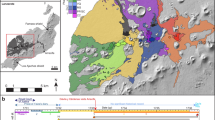Summary
¶The Campanian Plain is an 80 × 30 km region of southern Italy, bordered by the Apennine Chain, that has experienced subsidence during the Quaternary. This region, volcanologically active in the last 600 ka, has been identified as the Campanian Volcanic Zone (CVZ). The products of three periods of trachytic ignimbrite volcanism (289–246 ka, 157 ka and 106 ka) have been identified in the Apennine area in the last 300 ka. These deposits probably represent distal ash flow units of ignimbrite eruptions which occurred throughout the CVZ. The resulting deposits are interstratified with marine sediments indicating that periods of repeated volcano-tectonic emergence and subsidence may have occurred in the past. The eruption, defined as the Campanian Ignimbrite (CI), with the largest volume (310 km3), occurred in the CVZ 39 ka ago. The products of the CI eruption consist of two units (unit-1 and unit-2) formed from a single compositionally zoned magma body. Slightly different in composition, three trachytic melts constitute the two units. Unit-1 type A is an acid trachyte, type B is a trachyte and type C of unit-2 is a mafic trachyte.
The CI, vented from pre-existing neotectonic faults, formed during the Apennine uplift. Initially the venting of volatile-rich type A magma deposited the products to the N–NE of the CVZ. During the eruption, the Acerra graben already affected by a NE–SW fault system, was transected by E–W faults, forming a cross-graben that extended to the gulf of Naples. E–W faults were then further dislocated by NE–SW transcurrent movements. This additional collapse significantly influenced the deposition of the B-type magma of unit-1, and the C-type magma of unit-2 toward the E–SE and S, in the Bay of Naples. The pumice fall deposit underlying the CI deposits, until now thought to be associated with the CI eruption, is not a strict transition from plinian to CI-forming activity. It is derived instead from an independent source probably located near the Naples area. This initial volcanic activity is assumed to be a precursor to the CI trachytic eruptions, which vented along regional faults.
Similar content being viewed by others
Author information
Authors and Affiliations
Additional information
Received October 23, 2002; revised version accepted July 29, 2003
Rights and permissions
About this article
Cite this article
Rolandi, G., Bellucci, F., Heizler, M. et al. Tectonic controls on the genesis of ignimbrites from the Campanian Volcanic Zone, southern Italy. Mineralogy and Petrology 79, 3–31 (2003). https://doi.org/10.1007/s00710-003-0014-4
Issue Date:
DOI: https://doi.org/10.1007/s00710-003-0014-4




